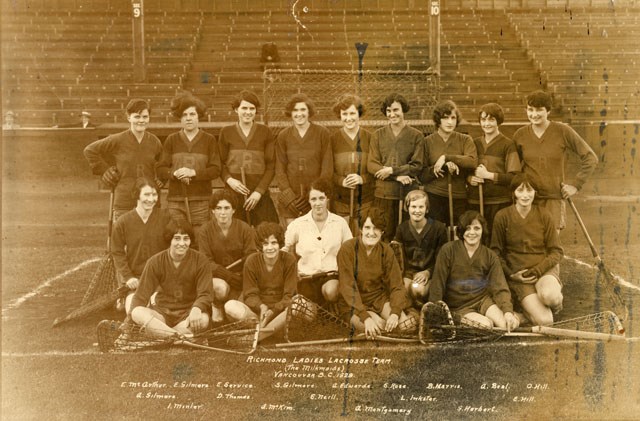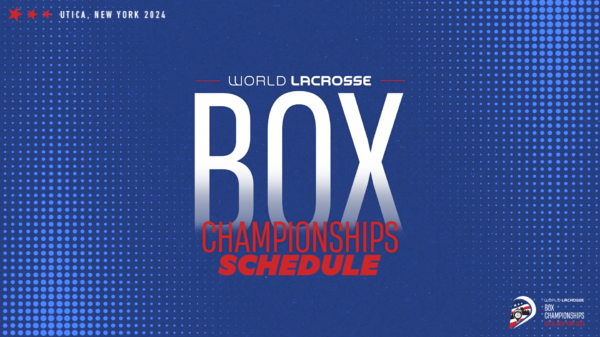Fawn Porter always felt like she had to prove herself.
A 7-year-old girl playing lacrosse with a bunch of boys, and the fact that she was nearly as tall as the goal post didn’t make it any easier for her to fit in.
“I didn’t really have a role model or someone I could share that experience with because a lot of times, the boys singled me out for being a girl,” Porter said. “It was kind of like initiation every year to see if I was good enough to hang with the boys.”
And this wasn’t field lacrosse, either; it was box lacrosse, with its enhanced physicality and contact, especially compared to the women’s field game. But Porter loved the style of box, and the only avenue for her to play was with boys.
In case the gender disparity wasn’t enough of a hurdle to overcome, her decision wasn’t exactly accepted culturally. Coming from an indigenous family, girls weren’t usually allowed to play box lacrosse. Field lacrosse was accepted because, as Porter described, “it’s less aggressive.” But in a family with traditional values, getting them to accept her decision to pursue the sport was no easy task.
She had every reason to quit, yet she never did.
Megan Kinna – who now plays for the New Westminster Salmonbellies – had a similar story growing up in British Columbia, playing box lacrosse with her brother who was two years older. She played with boys until she was 12 years old.

Such has been the case for so many women who play box lacrosse, a sport that’s had its peaks and valleys across Canada starting in the 1930s all the way to present day. Among intermittent stops and starts, World War II halted women’s leagues across the country; however, women’s box lacrosse and the athletes who loved the sport persevered to expand the game.
Now, nearly 20 years after Porter and Kinna first picked up a box lacrosse stick, young girls all over have taken up the sport.
“There’s like a billion girls playing down here on my reserve,” Porter said. “It’s so amazing to see because you can just see the light in their eyes. They’re allowed to have that excitement now; they have role models, it’s a norm for them now.
“They don’t have to go against the grain anymore or have anyone come at them for a sport they just so happen to love. I just love that.”
‘I want to get in on this’
It began in the late 1920s in British Columbia. A team of women came together and called themselves the Richmond Milkmaids.

This became part of the Women’s Lacrosse League, a field lacrosse operation, featuring teams from across the province. By the mid-1930s, fielding teams became quite challenging, so they pivoted to box lacrosse.
In 1936, the Women’s Box Lacrosse League formed, though players wore just gloves. Protective equipment would come later. The team from Richmond, then known as the Richmond Buddies, won the British Columbia Women’s Provincial Box Championship in 1936 and 1937.
Just four years later, though, the league came to an end. World War II pulled women into the wartime effort, and the league was unsustainable.
Seemingly dormant for the next three decades, women’s box lacrosse returned in 1972, mostly in British Columbia and Ontario. Michelle Bowyer, then just 14 years old, saw both of her brothers have the chance to play. A high school friend approached her about joining their own separate girls’ box lacrosse team in her hometown of Port Coquitlam.
“I was always intrigued by the game,” Bowyer said. “Box lacrosse, like that’s what people did on a weekend. You went out and watched your local senior men’s team. So my parents had their team that they cheered on, and that was a social thing that people did. Lacrosse was such a big sport, and then you watch people play box in the higher leagues. I thought, ‘Oh man, I want to get in on this.’”
From 1972 to 1974, Bowyer played for her hometown team, but the team soon disbanded; once again, a lack of players proved to be a problem. By 1981, Bowyer and a number of her teammates were drawn into the field game, excited to compete across Canada and on an international stage.
Box lacrosse virtually became extinct.
Nothing to strive for
Though they straddle two generations of box lacrosse players, Bowyer, Porter and Kinna echoed the same challenge that existed in the early 1980s and the 2000s when women’s box lacrosse failed to gain much traction: There wasn’t much to play for other than the love of the sport.
As Porter explained, that passion isn’t enough for long-term sustainability.
“We’ve always played because we love it, but lacrosse is hard to train for, to be in that mindset,” she said. “Now that we’re older, a lot of people that play down here from Six Nations have kids that they have to find babysitters for, so there are so many more hurdles and barriers to overcome.”
Those increased barriers, coupled with the intensity of the sport and lack of direct goals means some would put down their stick for good.
“When there’s not really this fine line goal, you’re just playing for your love of it, it’s not that you don’t want to put your all into it, but you only want to play because you’re having a good time,” Porter said. “If you’re becoming exhausted from practice, exhausted from games, the season’s kind of taking you out a little bit, it’s hard to keep going.”
Added Bowyer: “The sad thing is, a lot of the players, when they reach about 17 or 18, there’s just not much offered for them. This is across Canada, so they age out. There’s just sort of no carrot, no light at the end of the tunnel.”
In fact, Porter herself – now 25 years old – planned on retiring after she played with the Haudenosaunee in the 2022 World Lacrosse Women’s Championship. She’d already won an Ontario championship, and she didn’t feel like there was much else for her to accomplish.
But now, the Women’s Major Series Lacrosse continues to grow (it recently added three new teams), and World Lacrosse announced that it will host the first ever women’s edition as part of the Box Championships in Utica, New York, next year.

“It’s always been kind of like a dream to finally get a chance to play on a stage like that,” Porter said. “I just have to put the retirement on hold for a little bit and come back to the sport I love.”
It’s a big shift from when Porter’s box lacrosse career first began.
A major factor in the growth stems from Bowyer co-founding the Women’s Box Lacrosse Global Network in 2020, helping to create both centralization for the sport and an avenue to continue to raise awareness and spread the game.
“It’s lighting a fire,” Bowyer said. “I’ve gone out and talked to girls as young as 8, 9 years old, all the way up to senior level women. When you tell them there’s a world championship, their eyes just light up. You can feel the level of excitement now as girls anticipate that opportunity.”
In April, Prague hosted the second “She-Box” event that featured eight teams from seven countries, including Hong Kong, China.

“I’m standing there talking to the head coach of the Hong Kong women’s box lacrosse team. Even a couple years ago, if you would’ve asked anybody, they’d be like, ‘No, that’s crazy talk,’” Bowyer said.
Another factor, Kinna posited, is a pipeline of women who played box lacrosse in Canada before having successful college careers in the United States. She cited her former college teammate, Selena Lasota, whom she played with at Northwestern University as an example.
“I think once Selena got there and players were seeing people like her getting into schools and going down to the states and playing, it made a difference,” Kinna said. “I think there’s a recruitability piece for a lot of kids who want to go to college, and it improves your ability to play both games.”
This combination of outreach from organizations like the Women’s Box Lacrosse Global Network, the persistence from the players themselves and the success some have had with the field game in the United States has continued to elevate the sport’s value.
“It’s the women themselves for the better part that have really been working hard, very hard, to recruit players, to form leagues to get themselves to tournaments so they can play at a higher level,” Bowyer said. “Things are moving very quickly all of a sudden.”
‘A more level playing field’
Even box lacrosse players admit that the sport’s physicality isn’t for everyone. But for Bowyer, it’s always been the right fit.
“The very first time I had a box lacrosse stick in my hand, it literally just felt like it was meant to be there,” she said. “I’m not a very big person, and I played a lot of other sports, but the thrill of putting on a suit of armor so to speak and going into this physical game was exhilarating.”
Porter expressed similar affection.
“I just loved the aggressiveness of it,” she said of why she was drawn to the sport. “I was a little bit bigger for my age. I was always taught to be more gentle because I’m a girl, and then once they threw me in box I’m like, ‘Yeah, I’m tougher than the guys.’ That would give me this amazing sense of purpose.”
That pushback on stereotypes still remains front of mind for those involved in the game to help bring more female athletes into the fold and also provide them with the same opportunities as their male counterparts.
With more opportunities now for young girls to pick up the game, that should only provide a more level playing field in the future.
“The boys, we think they’re so good at the junior level because they’re good at that age, but really it’s because they’ve played their whole life,” Porter said. “Now we have girls starting so young, so I can’t even imagine the skill sets that are going to come.”
And not only does the explosion of box lacrosse mean improved gender equity for female athletes, it also brings more athletes into the sport, some who might not have gravitated toward the field version of the game.
“You have these little girls, and they feel fierce and they feel strong and they feel powerful because they’ve got this equipment on, and they can get knocked down and get right back up,” Bowyer said. “There’s something magical about it. I think it really has to do with the fact that it’s not like other sports. There’s nothing like the exhilaration of box lacrosse. It’s just so fast and so intense and so physical, and I think it really appeals to a certain athlete that really just wants to take that compete level to a whole different level.”
Kinna dreams of a future where women have the chance to play box lacrosse at Canadian universities. Perhaps, she said, maybe even American players would come to Canada to further their box lacrosse careers.
“In Canada, to be able to have our own university-level play within our Canadian universities and colleges would be something that I have always dreamt about providing for other players who fall in love with the sport and want to play in college but don’t necessarily want to go into the field lacrosse route,” she said. “Having women’s teams in colleges would be something incredible for the future of the game and having an outlet maybe for other countries and American players to come up to Canada and give scholarships to attend Canadian university. I think that would be a cool and different look for sure.”
While there’s still much work to do on all fronts, from the youth levels to the college level and beyond, there’s a level of reassurance that’s never really existed before with women’s box lacrosse: It’s here to stay.
“I’m happy that the girls are finally getting this opportunity to expand on that love for the sport we have,” Porter said. “It’s nice to have a bigger reason to continue skill building and continue playing a sport and have something to try for. Especially for the younger generation, they’re going to be insane when they finally get to this level. We just have to make it ready for them.”






